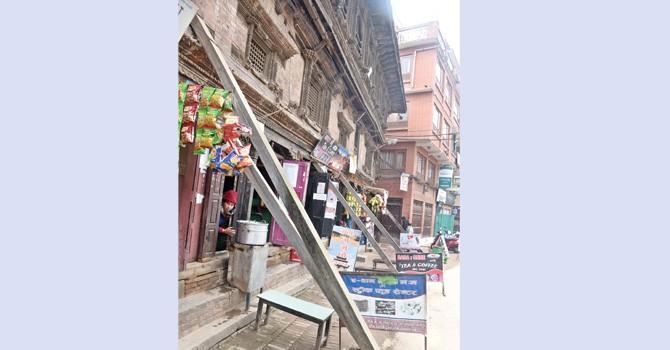Core city houses still standing on wooden logs support, putting people’s life at risk

By Indira Aryal
Kathmandu, Jan.17: Five years after the massive earthquake hit the country, most of the traditional houses and historic temples are still standing with the support in the core areas of Kathmandu.
When this scribe visited the core city areas, it was found that foreign and domestic tourists and locals were observing the historic buildings having buttressed by wooden logs, which has put lives of people visiting these areas even five years after the divesting earthquake.
The 2015 Gorkha Earthquake had killed 9,000 people, injured 22,000 and destroyed over 780,000 homes in central Nepal, including the Kathmandu Valley.
It is estimated that around 100,000 people are still living in emergency makeshift accommodation since then. Many people in the core city areas in the valley are still staying in the damaged, dilapidated houses supported by the wooden logs.
The old traditional buildings in Janabahal are awaiting renovation. People in the area are facing a risk to their lives living inside the dilapidated house.
It has been five years since Nani Maiya Shrestha’s house has been standing with wooden support. Her family is running a business at the ground floor of their dilapidated house that has still no sign of getting reconstructed any time soon.
Shrestha said that to reconstruct her dilapidated house, an adjoining house of her neighbour should also be reconstructed. She has no option but to wait her neighbour to start building her house simultaneously.
The House of Kumari in Basantapur is also standing in the support of wooden shafts since the 2015 earthquake. The building, with 300 years of history, is awaiting reconstruction work but none of the concerned authority is serious about fixing it.
The temple, which is in the main tourist hub of Basantapur Durbar Square, remains the same since the deadly quake rattled it.
Likewise, the house of Raj Bhai Sthapit in Mahabauddha-27 is still awating renovation after standing in the support of multiple wooden logs.
The 11-member family used to stay in a small house with few rooms. But the 2015 earthquake displaced them as the house was not good enough to stay in.
Sthapit is running a medical shop in the same dilapidated house. He said, “We don’t have enough money to reconstruct this house so we asked for support from the government, but we have been denied support.”
Shree Krishna Timilsina of Dhading said he was in Kathmandu when the 2015 earthquake hit the country. He witnessed the building falling and people running over.
Timilsina said that everyone should follow the building code to protect themselves from a similar disaster in the future.
Mahindra Lal Pradhan, resident of Mahabauddha-27, said that his father died inside his house in the earthquake. During the earthquake, all of the family members were outside and only his 75 years old father was staying alone in the house. He died on the spot on April 12.
Pradhan, who has just constructed a new building on the same place where his old house was destroyed by the earthquake, said he followed all the government measures while constructing new house. The house was completed one year ago.
He said that he tried to seek help from the government for the reconstruction of his damaged house but he was tired of following the lengthy government procedures. He said that he built the seven-and-a half-storey building as all his neighbours had built their houses with same height.
A magnitude 7.8 earthquake struck in the country toppling multi-story buildings in the Kathmandu Valley. It was the deadliest earthquake in the seismically active region in 86 years. Earlier, an 8.1 magnitude earthquake had hit the nation on January 16, 1934.
The quake was followed by hundreds of aftershocks. Hundreds of thousands of people lost everything and faced extreme poverty.
More than 800,000 homes were destroyed.
According to the Nepal Reconstruction Authority, the situation of reconstruction is very weak inside the valley due to the low source of income.
Social mobiliser Jamuna Maharjan said the people feared to retrofit their homes as most of the houses were constructed adjoining with one another. “If work to reconstruct one house starts, construction of another house should begin simultaneously. But lack of funds and family feuds have caused delay in the reconstruction of damaged houses in the core city areas,” she added.
Recent News

Do not make expressions casting dout on election: EC
14 Apr, 2022
CM Bhatta says may New Year 2079 BS inspire positive thinking
14 Apr, 2022
Three new cases, 44 recoveries in 24 hours
14 Apr, 2022
689 climbers of 84 teams so far acquire permits for climbing various peaks this spring season
14 Apr, 2022
How the rising cost of living crisis is impacting Nepal
14 Apr, 2022
US military confirms an interstellar meteor collided with Earth
14 Apr, 2022
Valneva Covid vaccine approved for use in UK
14 Apr, 2022
Chair Prachanda highlights need of unity among Maoist, Communist forces
14 Apr, 2022
Ranbir Kapoor and Alia Bhatt: Bollywood toasts star couple on wedding
14 Apr, 2022
President Bhandari confers decorations (Photo Feature)
14 Apr, 2022











